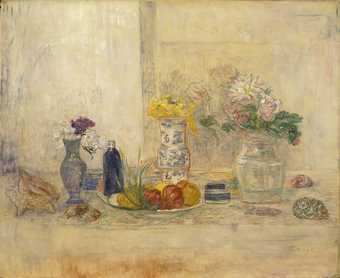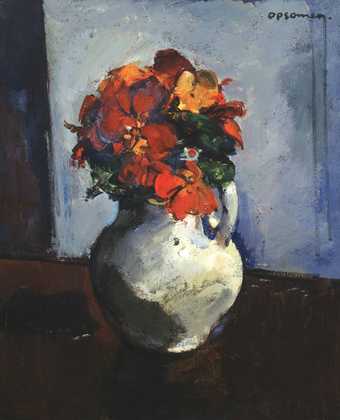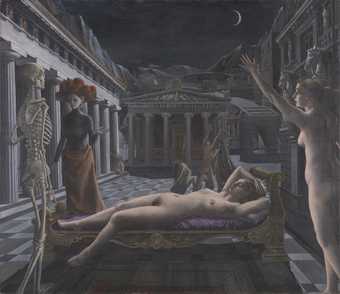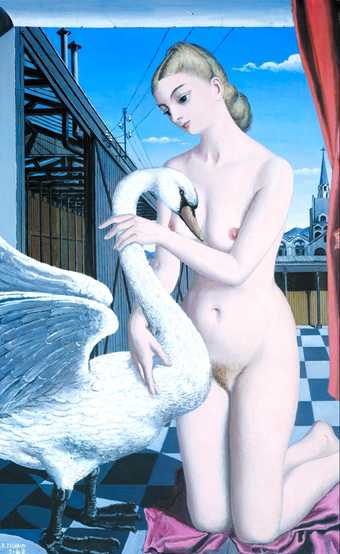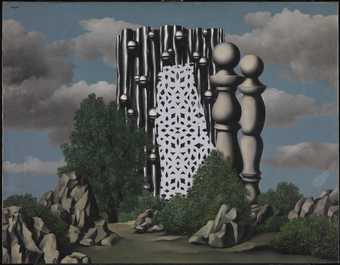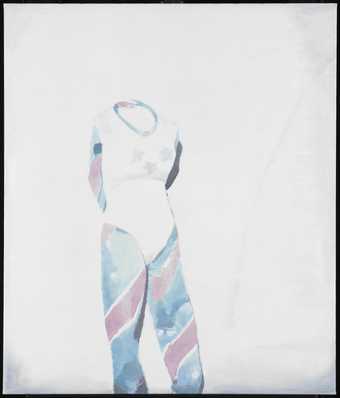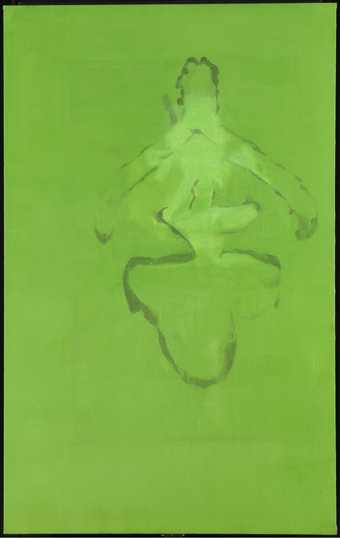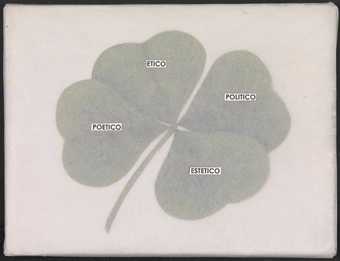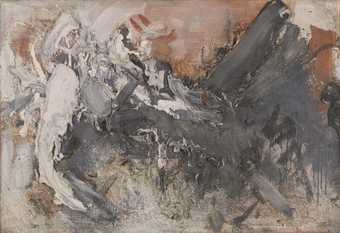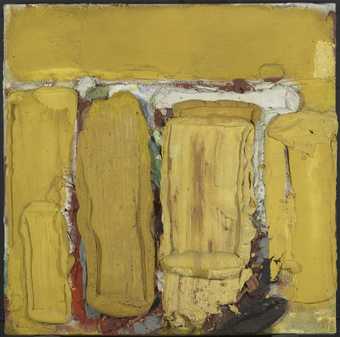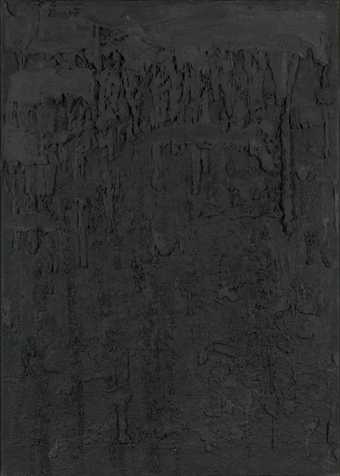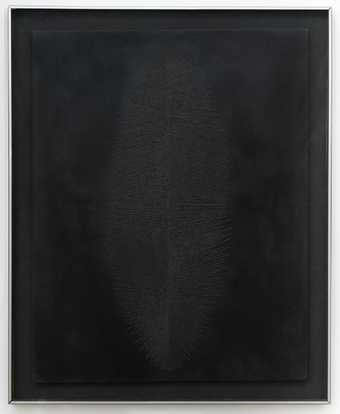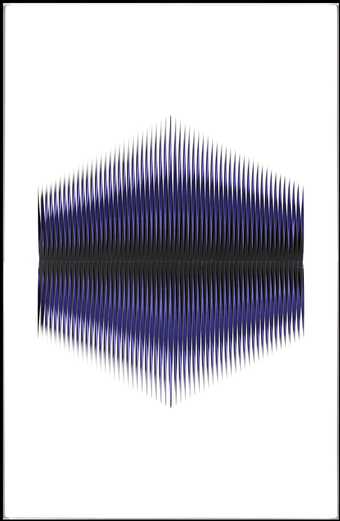
In Tate Modern
- Artist
- Evelyne Axell 1935–1972
- Medium
- Oil paint, zip-fastener and helmet on canvas
- Dimensions
- Unconfirmed: 1330 × 830 mm
- Collection
- Tate
- Acquisition
- Purchased with funds provided by Tate International Council 2016
- Reference
- T14349
Summary
Valentine is a painting by the Belgian artist Evelyne Axell. It comprises a gold background, with a white female figure, in pin-up pose, painted in silhouette. A long zip extends down the body of the figure, following the line a piece of clothing may take. When unzipped, it creates a narrow gash in the white paint, exposing a flesh-coloured surface beneath. This surface exposes a cleavage-like curve, the imprint of a belly button and a suggestion of pubis. Next to the figure, on the left-hand side of the canvas, hangs a white helmet with a Perspex visor.
One of the first female European artists to fully embrace pop art from the mid-1960s, Axell engaged, throughout her short career as an artist, with a proto-feminist depiction of the emancipation of woman’s sexuality. An acclaimed theatre and film actress, Axell turned to painting in 1964, taking lessons with family friend René Magritte (1898–1967). Her husband, the film director Jean Antoine, had just produced a documentary on American pop artists and, while filming another one, introduced Axell to British pop artists Patrick Caulfield, Pauline Boty, Peter Blake, Allen Jones and Joe Tilson. Fascinated by their work, Axell immediately drew on pop’s visual vocabulary. In 1967, discovering plastic materials, she developed her signature technique, adapting her painting to the possibilities offered by the new material. Cutting female silhouettes into translucent plastic sheets and enamel painting, she created provocative works infused with desire and eroticism. From her early works until her premature death, Axell depicted the female body and glorified female sexuality and fantasies.
Tackling the deep changes occurring within an increasingly disputed, gendered social order, Axell’s early work Valentine depicts the liberation of the female body and the uncovering of embodied intimacy, within the context of the 1960s space race. Axell selected as the emblem of her cause the Soviet cosmonaut Valentina Tereshkova. An idealised silhouette projecting from a gilded background, Axell’s Valentine is both a feminist heroine and a monument to female eroticism. The cosmonaut can be zipped and unzipped, while a toy helmet (courtesy of Axell’s son Philippe) hangs, unoccupied nearby – another provocation to participate, which the artist took up in a photograph from 1967 (see Elsa Coustou, ‘Artist Biography: Evelyne Axell’, Tate, September 2015, http://www.tate.org.uk/whats-on/tate-modern/exhibition/ey-exhibition-world-goes-pop/artist-biography/evelyne-axell, accessed 21 June 2016). Influential critic of the time Pierre Restany related Axell’s work to ‘sexual revolution’, a revolution linking woman’s emancipation with female eroticism (Restany cited in Jean Antoine, ‘Stages in a Life Cut Short: Biography of Evelyne Axell’, in Evelyne Axell: Du Viol d’Ingres au retour de Tarzan, Saint-Étienne 2006).
Further reading
Jean Antoine, Evelyne Axell: l’Amazone du Pop Art, exhibition catalogue, Centre Wallonie-Bruxelles, Paris 2000.
Bernadette Bonnier, Evelyne Axell: From Pop Art to Paradise, exhibition catalogue, Musée Félicien Rops, Namur 2004.
Flavia Frigeri, ‘1966 in the World of Pop’, in Jessica Morgan and Flavia Frigeri (eds.), The World Goes Pop, exhibition catalogue, Tate Modern, London 2015, pp.43–58.
Flavia Frigeri
July 2015
Supported by Christie’s.
Does this text contain inaccurate information or language that you feel we should improve or change? We would like to hear from you.
Display caption
In Valentine Axell combines an idealised feminine silhouette with a spacesuit helmet. It was made during the 1960s space race, when the United States and the Soviet Union competed for dominance in space exploration. The title refers to Soviet cosmonaut Valentina Tereshkova, the first woman in space. Axell presents her as both a feminist heroine and a sexualised figure. Axell’s paintings have been described as a ‘sexual revolution in art’. They combat gender discrimination, linking women’s political and social freedom with female sexuality.
Gallery label, August 2018
Does this text contain inaccurate information or language that you feel we should improve or change? We would like to hear from you.
You might like
-
James Ensor Effect of Light
1935 -
Isidore Opsomer Vase with Dahlias
1935 -
Paul Delvaux Sleeping Venus
1944 -
Gustave Singier Provence I
1957 -
Paul Delvaux Leda
1948 -
René Magritte The Annunciation
1930 -
Luc Tuymans Illegitimate III
1997 -
Luc Tuymans Illegitimate I
1997 -
Francis Alÿs Untitled
2000–10 -
Bram Bogart Threatened Cockerel
1956 -
Bram Bogart White plane white
1974 -
Bram Bogart Rye Summer
1963 -
Bram Bogart Absolution
1959 -
Walter Leblanc Twisted Strings, 80F X 477
1960 -
Walter Leblanc Torsions, CO 459
1974

